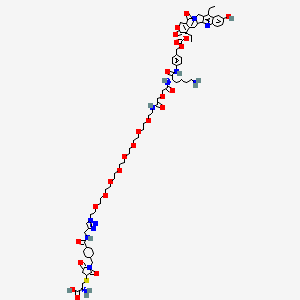



1. Hrs7-sn38
2. Immu-132
1. Sacituzumab Govitecan [usan]
2. 1491917-83-9
3. Hrs7-sn38
4. Unii-m9byu8xdq6
5. Hrs 7sn38
6. Immu 132
7. Immu-132
8. Satralizumab Linker
9. Sacituzumab-govitecan
10. M9byu8xdq6
11. Da64t2c2io
12. Cysteinyl Cl2a-sn-38
13. Sn-38 Cysteinyl Conjugate
14. Dtxsid401335985
15. Ex-a4354
16. Govitecan Cysteinyl Conjugate
| Molecular Weight | 1601.8 g/mol |
|---|---|
| Molecular Formula | C76H104N12O24S |
| XLogP3 | -3.3 |
| Hydrogen Bond Donor Count | 8 |
| Hydrogen Bond Acceptor Count | 30 |
| Rotatable Bond Count | 54 |
| Exact Mass | 1600.70071340 g/mol |
| Monoisotopic Mass | 1600.70071340 g/mol |
| Topological Polar Surface Area | 498 Ų |
| Heavy Atom Count | 113 |
| Formal Charge | 0 |
| Complexity | 3150 |
| Isotope Atom Count | 0 |
| Defined Atom Stereocenter Count | 3 |
| Undefined Atom Stereocenter Count | 1 |
| Defined Bond Stereocenter Count | 0 |
| Undefined Bond Stereocenter Count | 0 |
| Covalently Bonded Unit Count | 1 |
Sacituzumab govitecan is indicated for adult patients with metastatic triple-negative breast cancer (mTNBC) who have undergone two or more prior therapies for metastatic disease. Sacituzumab govitecan is also indicated for the treatment of locally advanced or metastatic urothelial cancer in adult patients who have received previous platinum-based therapy and either a programmed death receptor-1 (PD-1) or programmed death-ligand 1 (PD-L1) inhibitor. This indication has been approved under accelerated approval, and continued approval may be contingent on the demonstration of clinical benefit in confirmatory trials.
FDA Label
Treatment of breast cancer
Treatment of urothelial carcinoma
Trodelvy as monotherapy is indicated for the treatment of adult patients with unresectable or metastatic triple-negative breast cancer (mTNBC) who have received two or more prior systemic therapies, including at least one of them for advanced disease.
Sacituzumab govitecan is a humanized monoclonal antibody/topoisomerase inhibitor conjugate designed to induce DNA damage-mediated cell death preferentially in TROP-2-expressing cancer cells. Detailed pharmacodynamic studies have not been performed for sacituzumab govitecan, although as a therapeutic protein, there is potential for immunogenicity. In addition, sacituzumab govitecan has the potential to cause severe hypersensitivity, nausea and vomiting, and embryo-fetal toxicity. Patients who are homozygous for the uridine diphosphate-glucuronosyl transferase 1A1 (UGT1A1)*28 allele are at increased risk for neutropenia.
L01XC
L - Antineoplastic and immunomodulating agents
L01 - Antineoplastic agents
L01F - Monoclonal antibodies and antibody drug conjugates
L01FX - Other monoclonal antibodies and antibody drug conjugates
L01FX17 - Sacituzumab govitecan
Absorption
In patients receiving 10 mg/kg sacituzumab govitecan the Cmax of the conjugate was 243,000 45,600 ng/mL while the Cmax of free SN-38 was 127 60 ng/mL. Similarly, the AUC0-168 for the conjugate/free SN-38 was 5,210,000 1,230,000 and 3,900 1,830 ng\*h/mL, respectively.
Route of Elimination
No detailed information exists for sacituzumab govitecan elimination; renal elimination of SN-38 is known to be minimal, and it is expected that the fecal route will be the major contributor.
Volume of Distribution
Sacituzumab govitecan has a mean volume of distribution of 0.045 L/kg.
Clearance
Sacituzumab govitecan has a clearance rate of 0.002 L/h/kg.
The metabolism of sacituzumab govitecan has not been extensively studied. The SN-38 moiety is known to undergo O-glucuronidation by UGT1A1, presumably in the liver, and the SN-38 glucuronide metabolite SN-38G is found in the serum of patients undergoing treatment.
Sacituzumab govitecan has a mean half-life of 16 hours, while free SN-38 has a mean half-life of 18 hours.
Sacituzumab govitecan is an antibody-drug conjugate (ADC) targeting TROP-2-expressing cancer cells to induce DNA-damage-mediated cell death. The conjugate comprises a humanized anti-TROP-2 monoclonal antibody (RS7-3G11, also known as RS7) chemically linked by a hydrolyzable CL2A linker to the cytotoxic drug SN-38. The proposed mechanism of action first involves the binding of the RS7 component to TROP-2, which is highly expressed on the cell surface of multiple cancers. Binding of RS7 to TROP-2 results in rapid internalization of bound antibody, and the likely intracellular release of SN-38 via hydrolysis of the CL2A linker. SN-38 is an active metabolite of the anti-cancer drug [irinotecan], which is thought to work primarily through inhibition of DNA topoisomerase I, leading to DNA damage and eventual cell death. In addition, recent work has identified a possible secondary mechanism of action for SN-38 by disrupting the binding of Far Upstream Binding Protein 1 (FUBP1) to the _FUSE_ elements regulating oncogene expression. In addition to SN-38-mediated cell death, there is also some evidence that the RS7 component of the conjugate drug possesses antibody-directed cellular toxicity.